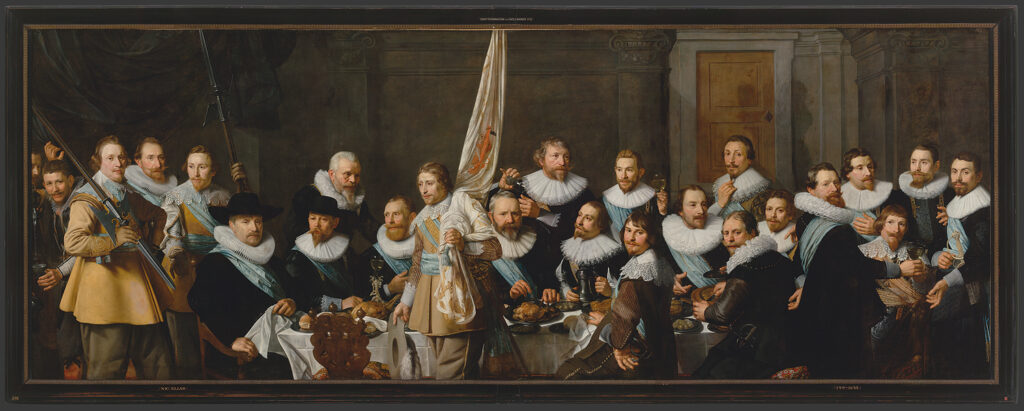Civic Virtue in Rembrandt’s Amsterdam: 17th-Century Group Portraits from the Amsterdam Museum shows how urban society in Amsterdam functioned in the 17th century in the aftermath of an unprecedented economic boom post-1600. The large paintings from this period, formerly known as the “Golden Age,” trace life in the largest city of Holland. Through the painters’ lens, we are presented with a society based on the collective responsibility of various classes that combined mercantile wealth with political power.
The large group portraits in Civic Virtue in Rembrandt’s Amsterdam have rarely left Amsterdam since they were commissioned in the 1600s and have never traveled in the United States as a group. In seventeenth-century Amsterdam, citizens known as “burghers” ruled the city. They were members of the elite and upper middle classes in a society dominated by clear class distinctions. The exhibition traces how life in the largest and most important city of Holland was based on the collective responsibility of these burghers, who combined their mercantile wealth with political power. These citizens, and in turn, the city, benefitted from an unprecedented economic boom around and after 1600, partly stemming from colonial trade. This exhibition will be the first to articulate for American audience show the exploitation of people on other continents made the so-called “Golden Age” possible. The large group portraits that form the nucleus of the exhibition were created to serve as artistic monuments of civic virtue as well as evidence of the pride of those portrayed. Exceptional paintings and objects exemplifying city life surround this core. The loans are selected from the Amsterdam Museum’s collections, with another five possible additions from the Rijksmuseum, Amsterdam and from museums in the United States. Several paintings will be restored for the exhibition.
During the seventeenth century, the young Republic of the Seven United Provinces of the Netherlands experienced an unprecedented period of prosperity in trade, science, and the arts, with Amsterdam at its center. A large group of wealthy merchants and successful craftsmen emerged in the cities, with newfound political power and authority. While the rest of Europe was dominated by monarchs and the church, the Republic was mainly governed by citizens. However, access to wealth and power remained limited to members of the affluent families that divided power and prestige among themselves. This exhibition demonstrates how these citizens used portraiture as an extension of their influence. In the commissioned group portraits, they sent a clear message: by governing and guarding the city, by organizing and managing a social safety net for the poor and needy, and by stimulating scientific and industrial developments, they contributed to making Amsterdam the most prosperous city in Europe. Portrayed as a new Rome or new Venice in this collection of works, Amsterdam is presented as the center of world trade. The city’s economic success, however, was the result of ruthless trade wars within Europe and colonization and enslavement overseas. To benefit from business, the men and women in charge practiced a live-and-let-live style of government. While they lived in impressive mansions built along the canals, other city residents struggled with poverty, housing shortages, or illness. For these residents, Amsterdam was a dangerous and unhealthy place. Diseases, such as the plague, claimed many victims, resulting in poverty, crime, and a high number of orphans. Although largely ignored in paintings, hints of this tougher life exist in the works included in the exhibition, for example in the (anonymous) 1627 panel The Almoners at Work: Distribution of Bread and Jan Victors’s The Feeding of the Orphan Girls of 1659. The works in the exhibition from the Amsterdam Museum’s prestigious collections are divided into eight sections, exploring representations of various facets of life at the time: “Introduction,” “Public Order,” “Care and Discipline,” “The Craft Guilds,” “City Life,” “The Economy,” “Family Values,” and “The Public and the Private.” Featured artists of great renown in the Dutch arthistorical world include Adriaen van Nieulandt, Gerrit Berckheyde, Ludolf Bakhuizen, Nicolaes Eliasz Pickenoy, Frederik Jansz, Dirck Santvoort, Ferdinand Bol, Bartholomeus van der Helst, Jan Victors, and of course, Rembrandt van Rijn. For the painters involved, portraying a group of guardsmen was a challenge, as each paid for their own portrait to be included and wanted to see themselves immortalized in a positive light. Striving for an attractive result, the composition of the paintings became increasingly natural over time, with fewer rigid poses and more interactions between the subjects.
ITINERARY




BOOKING
For booking information, contact Senior Curator Anke Van Wagenberg, PhD. at avanwagenberg@amfedarts.org
CO-ORGANIZER
The Amsterdam Museum, founded in 1926, is an innovative city museum which invites inhabitants and visitors of Amsterdam to become co-owners of the city of Amsterdam—a metropolis in miniature. It cares for and researches the more than 100,000 objects in its collection of art and heritage. This collection is in large part owned by the city of Amsterdam and therefore also by its people. The mission is to “connect Amsterdam’s inhabitants and visitors with each other and the city through programming, presenting, and collecting objects and stories from Amsterdam.
GUEST CURATOR
Norbert E. Middelkoop, PhD, has been the Curator of Paintings, Prints, and Drawings at the Amsterdam Museum since 1997. He has published and lectured on the collection, as well as on portraiture and city views. His PhD dissertation was focused on the Amsterdam corporate group portraits, followed by multiple publications on the subject.
PUBLICATION
The American Federation of Arts will produce an exhibition catalogue and brochure.
CREDIT
Civic Virtue in Rembrandt’s Amsterdam: 17th-Century Group Portraits from the Amsterdam Museum is organized by the American Federation of Arts.






